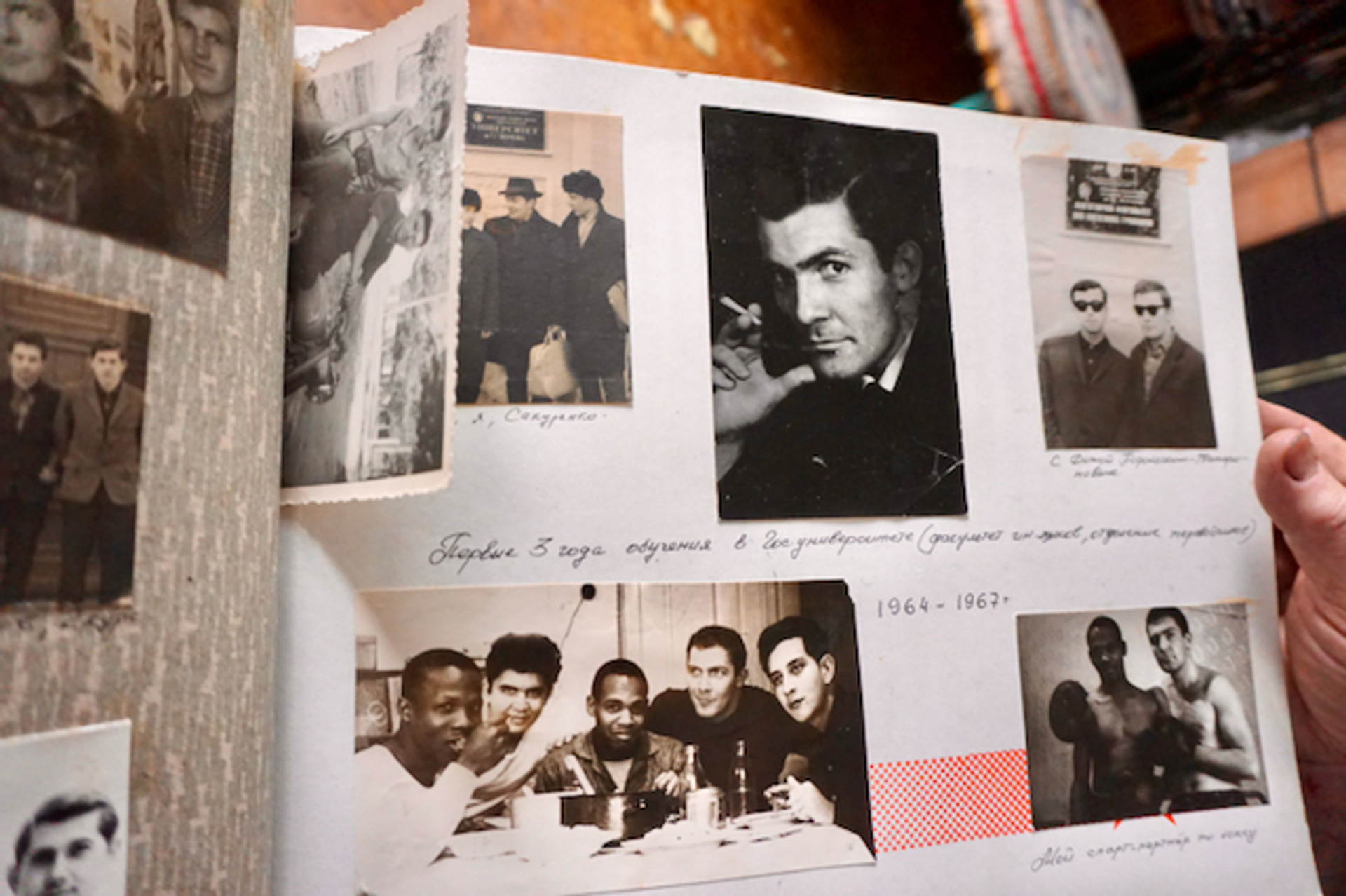A chunky yellow Labrador comes bounding down the sidewalk and into the street toward me. Trailing behind him is an older man repeatedly calling the dog’s name in Ukrainian: “Richi! Richi, come!”
The dog wants no part of going home while people are willing to pet him. Finally, the man, Petro Virko, 81, catches up with Richi and drags him by his collar down an entire block, back to their house. Or, I should say, to their self-built compound. When you’ve got an outdoor sauna, a carpentry workshop, a greenhouse and an underground bunker with more than one full bar and a rifle range, “compound” seems more appropriate.
Virko invites me in, but before he does, he stops in his leafy front garden to point to the spot where his adored previous Labrador, who was rusty red and 16, died a few months ago in a shock wave from a Russian bomb.
“It was probably a heart attack,” Virko says, his voice full of grief. He deeply misses that dog, who was also named Richi. The rambunctious yellow Lab he now lives with was found in some trenches nearby — his full name is Richi II.
Virko sees me and my fixer into his house. So now we’re sinking into dusty couches in his darkened, mildewed home in Horenka, a suburb about a half an hour northwest of Kyiv and about 10 minutes from Bucha. This village was the final front line of the thwarted Russian attempt to capture Kyiv. Bombed and invaded intermittently since Feb. 24, when the war began, the exhausted village, home to more than 5,000 people, held strong. Most people evacuated early; still, 33 have died, says Larysa Lishynska, a lawyer who put her job on hold to lead an effort to bring food and supplies to the village.
“You either watch,” she says, “or you help.”
Locals estimate that there has been damage to nearly 80% of the structures in Horenka; like so many villages that surround Kyiv, shattered windows are the norm, and, in a perverse kind of comedy, it seems like every other house has been destroyed. Unlike in neighboring villages, such as Bucha and Irpin (the sites of well-publicized massacres), in Horenka, I did not hear about people being shot in their cars as they fled.
When the Russians pushed toward Kyiv after landing at the nearby Antonov Airport — a key target in Russia’s goal to create an air bridge that would allow them to take the capital — soldiers went from house to house in these suburbs, taking with them everything from ovens to fishing poles as they searched for patriotic Ukrainians by making them strip. The idea was to find military and pro-Ukrainian tattoos. I’ve heard reports about men being tortured and killed because of such ink.
Regardless, Virko was one of a handful of men who stayed behind. He’s the stereotype of the cranky old man standing his ground: “It’s my house, my land, and I won’t leave it,” he says. Actually, replace “cranky” with “resourceful.” Like some of his neighbors, he’s old enough to have memories — however faint — of being in Ukraine at the end of World War II. And now he’s living through a near-facsimile of that period’s hungry aftermath. This time, though, he’s prepared for it, having stocked up and canned and pickled every vegetable imaginable.
Besides, he says, he wasn’t about to leave behind his dog — it’s just the two of them these days. His beloved wife died of skin cancer in 2004 from, he believes, radiation released during the Chernobyl meltdown in 1986. And, horrifically, his mother died in a massive 1961 landslide in Kyiv that some called the “revenge of Babyn Yar,” the site at which Nazis killed 100,000 Jews, Roma and political prisoners. A couple of months ago, Russians bombed a communications tower that overlooks the ravine. Some said Babyn Yar was hit, but it may not have been. I saw the damage to the tower, but not the site itself.
The term “fog of war” exists for a reason.
Virko has childhood memories of Russian planes flying west overhead — a tremendously exciting event to a toddler who loved planes. But one of his strongest memories comes from his mother. She told him she remembered being on a train to Kyiv with him when he was just a few weeks old and that the Germans bombed the rails so “they flew like matchsticks.”
“You have to experience it all firsthand,” Virko says of war. “You can prepare for anything, but no storytelling can prepare you for this. No movie can show you what it’s like to endure a shock wave.”
We talk a little more about why he stayed in Horenka during this invasion.
“I said to myself, maybe it’s something in my blood,” he says. “I have so many military men in my family.”
That he does. Virko spent time in the military himself as both a translator and a trainer of marksmen. His father went missing in World War II in 1943. His son spent decades trying to figure out what had happened to him. It wouldn’t be until the early 1970s that he would discover that his father had died in eastern Ukraine, in Luhansk — territory seized in this new war by the Russians.
Some of the Ukrainian survivors of World War II whom I spoke to are struggling to get through this present-day conflict. They are baffled, yet again, by the inhumanity of war. And while some of the people I talked to in June were OK with sharing their stories, like Virko, others were too overwhelmed to do so.
While in Horenka’s town square, I asked an older woman if we could speak. Her name is Tamara, and she is 84, dressed in a purple sweater-vest. Through my translator, I ask if she could tell me what she remembers from World War II and how she feels going through war again. Tamara takes a few moments before answering.
I had not noticed her trembling before, but now she is leaning heavily on a wooden cane, shaking and quietly crying. About four minutes pass in silence.
“I do not want to talk about this,” she eventually says as she grabs at her heart and then at my fixer’s arm for balance.
But Tamara stands there for another four minutes until finally saying: “I can’t talk. If I talk, I’ll fall apart.”
Everyone I meet copes differently. Some keep their pain inside; others face it head on.
Back at Virko’s house, he gestures for me to come with him into the next room. I pull myself up from his sunken, dog-furred couch so he can show me his library. Only once we get there, he reaches up to grab hold of one side of the bookcase and gently pulls, revealing a steep, secret stairwell. He descends, with Richi II following quickly behind.
“Follow me,” he says.
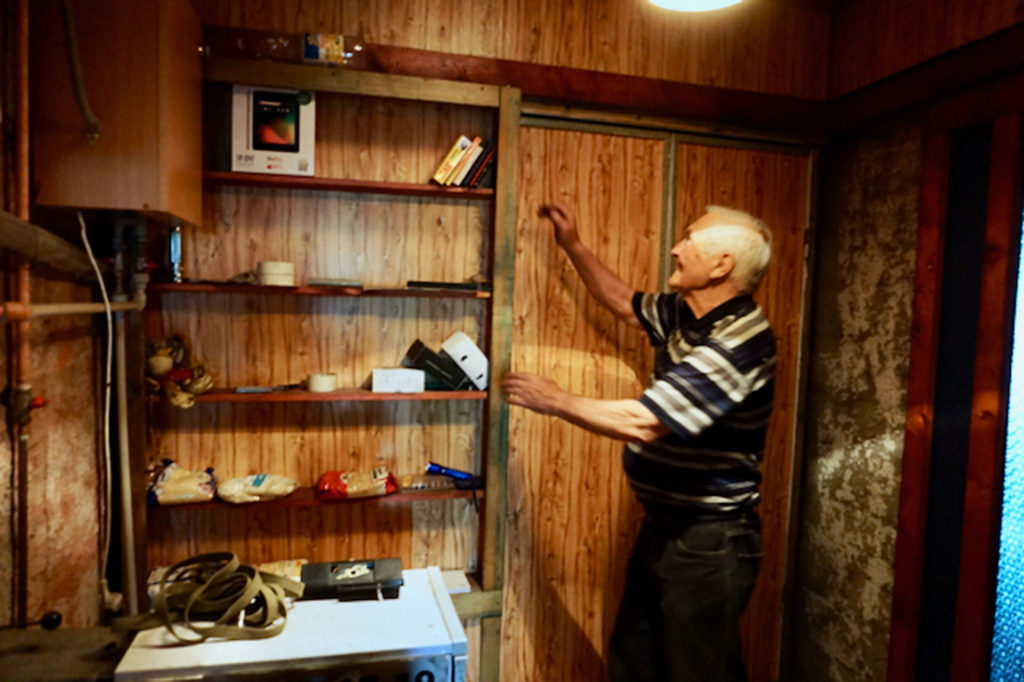
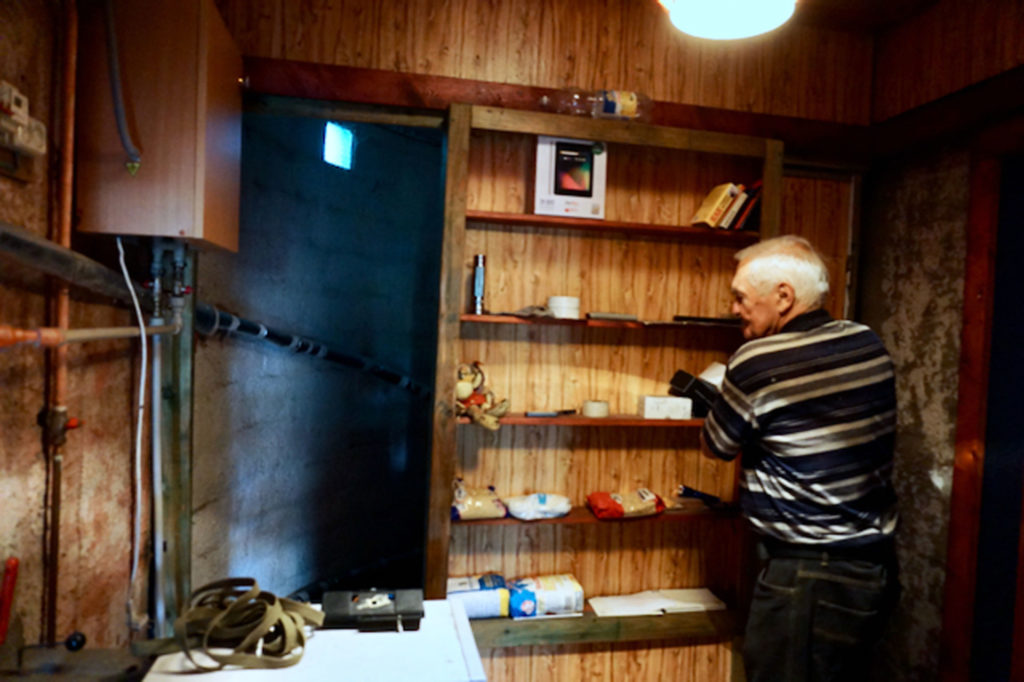
Ukraine has a history of occupation that is, in some ways, repeating itself in 2022. Not only in the sense that an outsider, Russia, is invading, as Germany did in 1941, but also in the way that the country’s agricultural industry has come to a near halt.
Less known is Ukraine’s history of starvation, a phenomenon that is again rearing its head, although hopefully not to the same degree as it did in the 1930s (it seems, for now, that the countries that import Ukraine’s grain are more at risk of famine than Ukraine itself). Just before World War II, Josef Stalin starved Ukraine of its grain, killing 3 million to 4 million people in 1932 and 1933. The genocide is called the Holodomor: literally, “murder by starvation.”
The day I met Virko, I was watching an international charity hand out food in Horenka’s town square — a donation reminiscent of earlier wars’ bread lines. A Washington, D.C.-based nonprofit called World Central Kitchen was giving out black Styrofoam meal boxes to mainly old people, although there were some boys (who looked too young to fight) who had also quietly gotten in line, their heads down.
When the charity declared they’d given out all the food they could, a few older women crowded the man who’d been handing out the meals from the back of a van — there were more boxes there, the women shouted. They were hungry. But the man said the other boxes were meant for the next village.
War creates a vicious kind of calculus.
An older man in the odd combination of a dashing, fedora-style straw hat and a see-through striped shirt approaches while I’m watching the food handout. Born in 1946, Oleg Stygach was born too late to have memories of the war, but he has distinct memories of the yearslong starvation that followed.
“The famine was really, really bad in those times,” Stygach says. “I worked catching fish to survive.” He was only about 3 years old.
As just a tiny boy, he didn’t speak until he was 3 or 4 because, he thinks, his limited diet of fish affected him — to the point where he attributes his full head of hair as a child to the high amount of phosphorus he was consuming by eating only fish.
I ask Stygach, who had been hamming it up for my camera a few minutes earlier, if he ever thought he would see war again in his lifetime. His reaction is immediate, and similar to others to whom I’ve asked this question. He instantly breaks into tears and, sniffling, says: “No one can believe this. It’s so scary when the planes fly overhead. All the windows explode. When the planes are near you, all the windows are shattering. It is really, really scary.”
As Stygach cries harder, he imitates the sound of jets and falling Russian artillery: “Pppppeeeeew bom!”
He used to be the head of one of the largest chicken farms in the Soviet Union, he says, but he is “now a pensioner and no one needs me.” Like so many others I speak to in his generation, he is dumbfounded that war has found them again in these late, quiet years.
“When it will end, no one knows,” he says. “Neither in Moscow nor in New York nor in Kyiv. It’s all shrouded in darkness. There’s just a lot of talk and no results.”
Back in Virko’s house, I continue down the curving stairs behind him and his dog, Richi II, on the steep spiral staircase he made, lined with magazine photos of hair bands from the 1980s.
Since arriving in Ukraine, I’ve seen a few basement shelters. In this war, you’re advised to either get to an underground shelter or behind two thick walls, away from windows. But while Virko has chosen the shelter route, his bunker is unlike others I’ve seen or heard about.
First stop on Virko’s bunker tour: the rifle range.
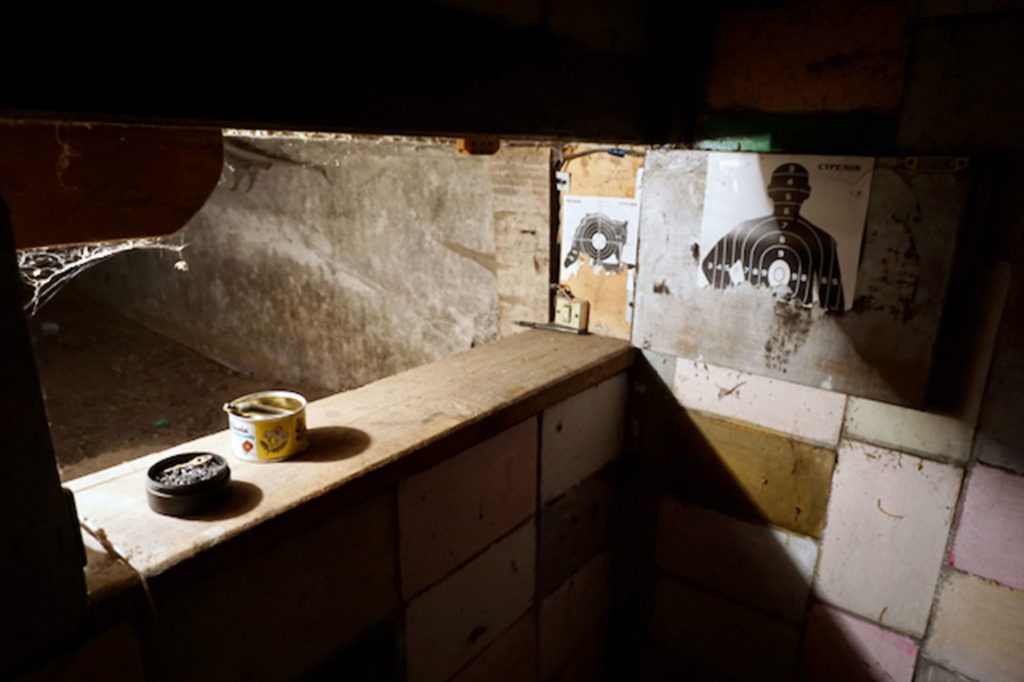
I warily duck beneath various webs to hunch down and peer through the length of the range, which has five targets at the far wall. On the ledge where we’re standing are a few tins — one of which is an old one for Ricola cough drops — containing spent and ready bullets. Virko explains that he used to teach marksmanship in the military, as well as, bizarrely, French. But teaching French became his career. He spent decades at a choreography school in Kyiv teaching ballerinas the language of their movements.
While in the bunker, Virko shows me a few cramped rooms with low ceilings, two of which sheltered other families during the worst of the Russian shelling in February and March. All three spaces have full bars, although one room in particular has the feel of a nascent nightclub. Virko flings open a cabinet door with the flourish of a showman to offer up glass jars of pickled vegetables.
“For vodka,” he says.
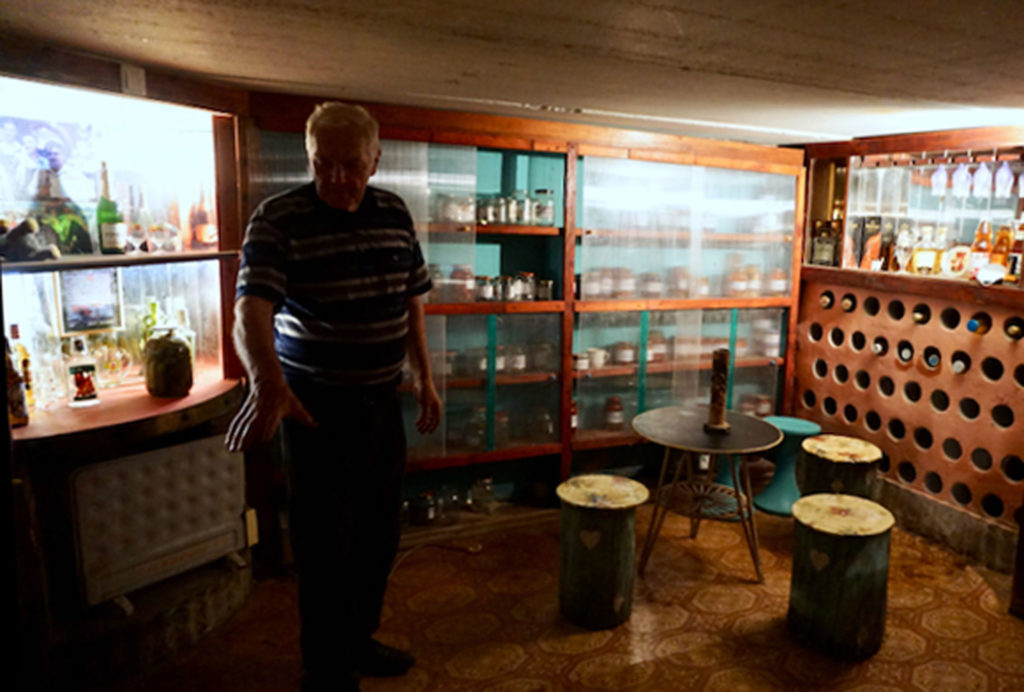
Svitlana Volgina is 86 and lives in Kyiv. A bit older than some of the people I’ve spoken to, Volgina has clearer memories of her life during World War II.
She remembers evacuating to Uzbekistan along the River Volga, where Nazis bombed the refugee boats so that “it seemed as if the water itself was burning.”
“The water was covered with oil and kerosene from the destroyed boats,” Volgina says. “It was all burning, and there were lots of people clinging onto the parts of the ships that had been destroyed. That’s how we traveled to Uzbekistan.”
During her family’s eventual return to Kyiv by train, she recalls that at one point she watched as feathers flew past her window and that there were strange mounds of dirt around the tracks. Her father learned that the train just in front of them had been hit, and that the feathers had come from pillows. The mounds were makeshift graves.
Volgina talks about how her little sister died when she was 3 at the end of the war from the cold. She was malnourished, with the family unable to find enough corn flour to make a porridge that might have saved her. Volgina remembers that the tiny bit of milk her mother was able to find went to her sister, even though her stomach was empty too. Medical care was unavailable, she says, reminding me of what doctors and nurses told me at Kyiv’s pediatric neurosurgery hospital a couple of weeks ago: that they know of many children who have died in this current war because the Russians haven’t allowed parents to evacuate them to hospitals that could save them.
In the madness of this invasion, there are children who have been shot in their cars while fleeing the invading Russians. I met a mother and father with empty eyes whose two boys, 3 and 12, were killed this way as the family tried to leave their village, Vorzel, northwest of Kyiv. Also, in the course of this war, many families have labeled their cars with signs that say “CHILDREN” in block letters. But as a shot-up car displayed in Kyiv’s Independence Square makes clear, signs are not necessarily a deterrent.
After about an hour, I am saying goodbye to Virko as he’s describing how he patrolled his own house with a gun in case the Russians came. But before I leave, there is one last thing he wants to show me: At the corner of his property, high on a pole wound with electrical lines, fly the bracing yellow and soothing blue of the Ukrainian flag.
“Six of us put it up there,” he says proudly, holding up his phone with liver-spotted hands to show me a photograph of him and the other men under the flag, holding guns. There was, at the time, a Russian checkpoint next to his house, so this was his way of giving those soldiers the middle finger.
When I ask Virko if he was ever afraid, he says he was not.
“I’m 81,” he says. “I’m not afraid of anything.”
His answer is not dissimilar to Volgina’s.
When asked what it is like for her to again go through war, Volgina says that “war in general is a horror.” With her wheat-colored curls and smooth skin, she looks much younger than her years. But there is no doubt that she has had enough experience of war for a lifetime. Still, she endures while others have withered.
“What can I say?” she offers. “I’m more resilient. For me, it’s easier.”
“Everyone goes through all this individually,” she says. “It depends on whether a person can cope with it emotionally, or can’t.”
But, as she considers the question further, she lands on: “I couldn’t ever have imagined that a modern war could be more horrifying than the Second World War.”



